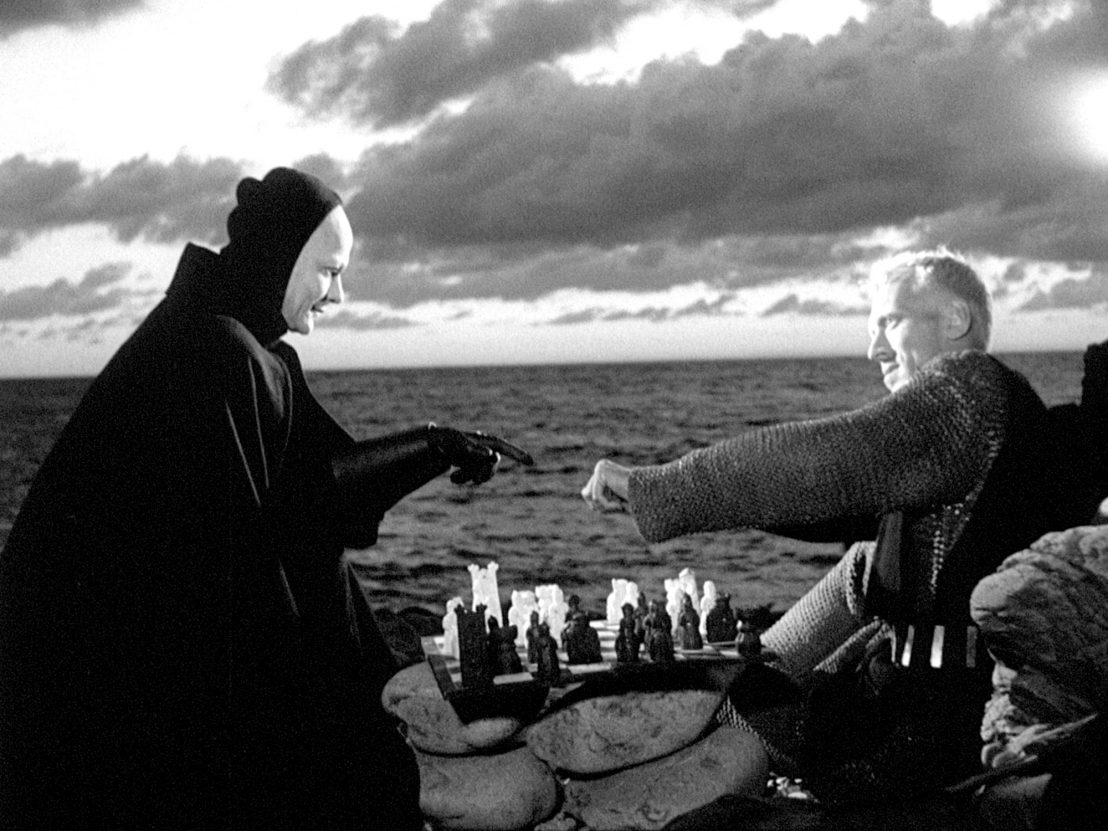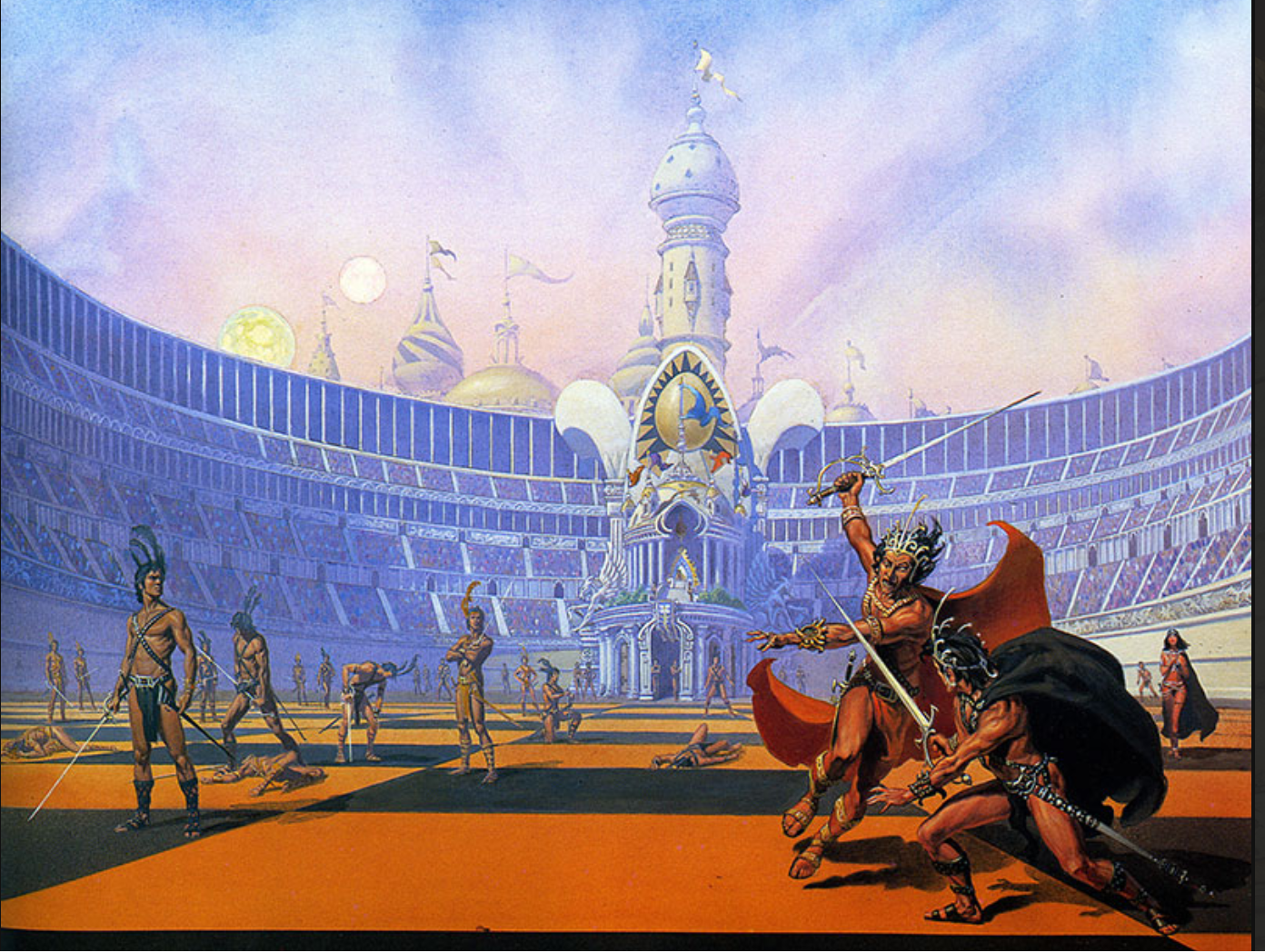Chess on Other Worlds
I have heard the bizarre rumor recently that some eccentric persons might not find chess to be a fascinating spectator sport, despite its frantic, kinetic action and breathtaking thrills.

In the picture above, I believe Ming of Mongo is attempting the Nimzo-Indian Defense but is being countered by the 4. e3 move by the psychopomp, ushering in the Rubinstein Complex. Or perhaps this is the Alatortsev variation being used in the opening to dodge the Exchange variation of the Queen’s Gambit Declined.
Without venturing my own opinion, I do think that if chess were fought as a bloody gladiatorial sport with living swordsmen dueling to the death before screaming crowds with glaring and sadistic eyes, death throes visible to all as lifeblood spurts into the hots sands of the arena, and all the living chessmen naked as jaybirds, this would add zest to an otherwise cerebral and tedious game.

After reading CHESSMAN OF MARS by Edgar Rice Burroughs in my youth, I have always thought that it was a requirement for every science fiction writer to invent at least one chess variation for his make-believe world, in order to give the place more character and versimilitude. Also to have at least one bloody gladiatorial scene, otherwise unjustified, crowbarred into the plot.
Similar extraterrestrial chess variants named or invented by epigones of Burroughs include:
- Lin Carter‘s Darza, from Renegade of Callisto, eighth volume in his Callisto series
- Kenneth Bulmer‘s Jikaida, from A Life for Kregen, 19th volume in his Dray Prescot series
- John Norman‘s Kaissa, from Players of Gor, 20th volume in his Gor series, not fully described
- S. M. Stirling‘s Atanj, from In the Courts of the Crimson Kings, his own Burroughs-influenced novel of an alternate Mars, also not fully described
- George R. R. Martin’s Cyvasse from his A Song of Ice and Fire series.
One could also list Wizard’s Chess from Harry Potter, the three-dimensional chess from Star Trek, or Dejarik, and the holochess game played on a round board, from Star Wars, of which various fans have offered several variants. To my knowledge, there is not an ‘official’ version of the rules from JK Rowling, or Gene Roddenberry, or George Lucas.
In case anyone is curious, my own favorite chess variation (if it is a variation) is Called Arimaa. Invented in 2003 by computer engineer Omar Syed after Kasparov’s defeat by chess computer Deep Blue, and named (in anagram) after his four-year-son, Arimaa was designed to be played with a standard chess set, be difficult for computers, but simple enough for his child to enjoy. You can find the rules here.
Jetan is a game, I assume, Burroughs never actually playtested. Like quidditch in Harry Potter, some games in stories are invented to lend drama to the hero, not to be playable.
Here, with no more comment, are the rules for jetan as explained to Burroughs by John Carter.
Jetan, or Martian Chess
Edgar Rice Burroughs
FOR those who care for such things, and would like to try the game, I give the rules of Jetan as they were given me by John Carter. By writing the names and moves of the various pieces on bits of paper and pasting them on ordinary checkermen the game may be played quite as well as with the ornate pieces used upon Mars.
THE BOARD: Square board consisting of one hundred alternate black and orange squares.
THE PIECES: In order, as they stand upon the board in the first row, from left to right of each player.
Warrior: 2 feathers; 2 spaces straight in any direction or combination.Padwar: 2 feathers; 2 spaces diagonal in any direction or combination.
Dwar: 3 feathers; 3 spaces straight in any direction or combination.
Flier: 3 bladed propellor; 3 spaces diagonal in any direction or combination; and may jump intervening pieces.
Chief: Diadem with ten jewels; 3 spaces in any direction; straight or diagonal or combination.
Princess: Diadem with one jewel; same as Chief, except may jump intervening pieces.
Flier: See above.
Dwar: See above.
Padwar: See above.
Warrior: See above.
And in the second row from left to right:
Thoat: Mounted warrior 2 feathers; 2 spaces, one straight and one diagonal in any direction.
Panthans: (8 of them): 1 feather; 1 space, forward, side, or diagonal, but not backward.
Thoat: See above.
THE GAME is played with twenty black pieces by one player and twenty orange by his opponent, and is presumed to have originally represented a battle between the Black race of the south and the Yellow race of the north. On Mars the board is usually arranged so that the Black pieces are played from the south and the Orange from the north.
The game is won when any piece is placed on same square with opponent’s Princess, or a Chief takes a Chief.
The game is drawn when either Chief is taken by a piece other than the opposing Chief, or when both sides are reduced to three pieces, or less, of equal value and the game is not won in the ensuing ten moves, five apiece.
The Princess may not move onto a threatened square, nor may she take an opposing piece. She is entitled to one ten-space move at any time during the game. This move is called the escape.
Two pieces may not occupy the same square except in the final move of a game where the Princess is taken.
When a player, moving properly and in order, places one of his pieces upon a square occupied by an opponent piece, the opponent piece is considered to have been killed and is removed from the game.
The moves explained. Straight moves mean due north, south, east, or west; diagonal moves mean northeast, southeast, southwest, or northwest. A Dwar might move straight north three spaces, or north one space and east two spaces, or any similar combination of straight moves, so long as he did not cross the same square twice in a single move. This example explains combination moves.
The first move may be decided in any way that is agreeable to both players; after the first game the winner of the preceding game moves first if he chooses, or may instruct his opponent to make the first move.
GAMBLING: The Martians gamble at Jetan in several ways. Of course the outcome of the game indicates to whom the main stake belongs; but they also put a price upon the head of each piece, according to its value, and for each piece that a player loses he pays its value to his opponent.
